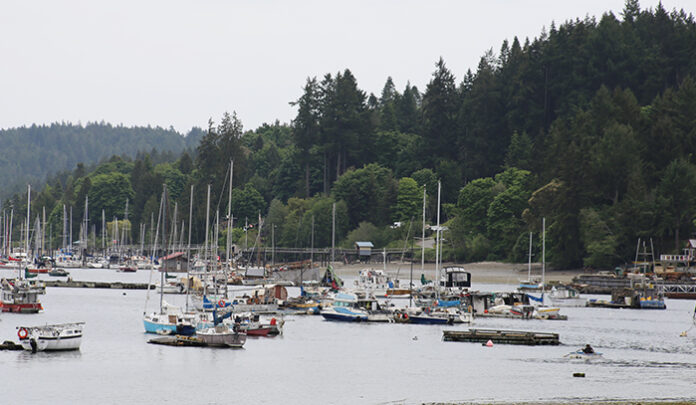Advocates for regulating liveaboards say they hope new polling data will help spur Salt Spring’s Local Trust Committee (LTC) into action.
The Safe and Clean Harbour Initiative (SACHI) citizens group this week released results from a poll they commissioned, and shared more about their proposal in advance of a formal delegation headed to the LTC June 22. Coordinator Glenn Stevens said the polling, conducted by local market research consulting firm Return On Insight, was part of a broader effort to find common ground to support the group’s overarching goals — reducing pollution in Salt Spring’s harbours, ensuring environmental and sanitation facilities for people living on the water, and “enforcement of sound usage of the harbour for everyone’s enjoyment.”
Stevens said SACHI would be bringing a citizen-drafted bylaw to the LTC in hopes of quick movement by trustees, and reached out to clarify some aspects of the proposal that he felt had been misunderstood prior to the plans being finalized.
“The proposed bylaw does not charge a fee to any of the liveaboards to be able to reside there,” said Stevens. “It would be up to the Trust to decide whether they want to impose a fee.”
Also, according to Stevens, the bylaw as proposed doesn’t require boaters to immediately insure their vessels to ensure compliance with regulations.
“Recognizing that it might take some people time to get insurance, if you are already in the harbour the bylaw proposes at least a one-year moratorium before the insurance would have to be in place,” said Stevens. “But anybody else coming into the harbour would have to have insurance.”
Stevens said the group actively working on the initiative comprised more than 30 people, and included island homeowners, beachgoers and business owners — who he said wanted their employees living on boats to have better housing security. Current Islands Trust land use bylaws prohibit people from living on their boats within Ganges Harbour, although that has been largely unenforced in recent memory as trustees seek to address the lack of lower-cost housing.
Rumours of a citizen-drafted bylaw brought some in Salt Spring’s liveaboard community to an LTC town hall last month, concerned that proposed regulation would make their living arrangements prohibitively expensive — or worse, that they might be forced to leave Ganges, where many said they work.
As SACHI has reached out, according to Stevens, early response from liveaboards to the idea of regulation has been mixed — but he was hopeful most people wanted the same things.
“Some of the liveaboards are very supportive,” said Stevens. “Some, not surprisingly, would not like to be bothered at all. But if you say to somebody, would you like a clean, safe harbour, [they answer] yes.”
And polling data, released this week by Bruce Cameron of Return On Insight, suggests many islanders who were asked agree. Cameron said SACHI’s questions were answered by 166 participants from his larger Salt Spring Insights online research panel in late May, and that the group was “demographically representative” of Salt Spring in terms of age, gender and where they live on the island.
Most survey participants were critical toward Ganges Harbour due to lack of cleanliness and safety, with a majority agreeing there were too many “derelict unsafe boats” and disagreeing that the harbour “has water that is clean and healthy for drinking or swmming.”
Most also said they would somewhat or strongly support bylaw changes and greater enforcement of existing rules to protect Salt Spring’s harbours “from becoming further polluted by the illegal dumping of waste and other discharge from vessels that are being used as permanent dwellings by their owners or users.”
Cameron said questions about whether participants felt uncomfortable in downtown Ganges or safe in Centennial Park — while not necessarily directly related to SACHI’s proposals — gave an indication that worries about the downtown area were at least partly responsible for results suggesting support for liveaboard regulation.
“I think these concerns about cleaning up downtown and providing access for families — and just being able to walk safely around the park — are big drivers of some of these attitudes that are so supportive of this initiative,” said Cameron. “One of the things I’ve picked up, certainly over the last couple of years, is that there’s a growing appetite on the island for getting stuff done.”
Stevens and fellow SACHI advocate Jack Speirs also said that the group was positioning itself to help create a charitable organization to address concerns about taxpayer cost.
“The idea was to form a federally incorporated charity that would be able to raise money — and issue tax receipts,” said Speirs, “and use the funds to clean up and deal with boats that have been abandoned, or derelict, or otherwise not being accountable to the regulations.”
Speirs added there had been “significant” interest, with funds being pledged should the proposed bylaw go through and the charity be concurrently formed; Stevens characterized that effort as “almost six figures” in pledges, and that funds could also be used to help pay for liveaboard services.
“Obviously this is a coastal-wide problem,” said Speirs. “But this is sort of a made-in-Ganges, Salt Spring-esque solution.”
Results from Return On Insight’s SACHI polling are available below. SACHI’s proposal, including text of its proposed bylaw, an executive summary, pictures and resource material will be posted on the Islands Trust website as supporting documents within the LTC’s June 22 agenda package, which will be updated later this week.
For additional information email SSISACHI23@gmail.com.











An ambiguous survey clearly does not represent the majority.
Perhaps a better survey question would be…
Do you support adding one million dollars to our Islands Trust tax requisition for a pet project from some “have yachts”?
Most of the live-aboard people are living under the poverty line and they need support for their livelihood. I believe that our society will get better and will improve if people are happy.